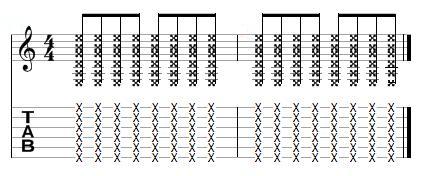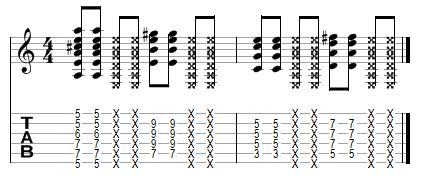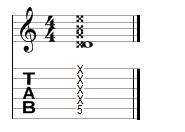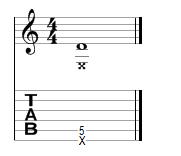Fret Hand Muting
Fret hand muting is a popular technique amongst rhythm guitarists. It involves using your left hand (which is the fretting hand for most people) to dampen the strings whilst your other hand strums. A percussive click should be produced without any ringing of the strings. Muting and chucking are alternative terms for fret hand muting.
Instruction:
- Rest your left hand (the hand that holds the frets) gently over all of the strings. Be careful not to apply pressure, the strings shouldn't touch the frets.
- Use your right hand to strum.
Tip - You may notice that muted strings are harder to strum. The fact that they are held in place means they create more resistance on the plectrum. This can be overcome by holding the plectrum with a relaxed grip and not muting the strings any more than they need to be.
A fret hand mute is represented by an 'x' in guitar tablature. On figure 1 (below) you will see that all six strings are muted for each strum. Play through figure 1 using alternate strumming (down up down up strumming). There are eight strums to be made in each bar but you should count in groups of four.
Figure 1.

In figure 2 (below) you can see how fret hand muting can be incorporated into rhythm playing. First, a chord is strummed twice, then two muted strums are made (on all six strings), followed by another chord and so on. Listen to the audio file to see how it is supposed to sound then play through the example. Try to play it to a metronome, strumming twice for eack click. You can make an easy transition from holding a chord to muting the strings simply by taking the pressure off the strings. When doing this you can keep your fingers in the chord shape, just make sure that you stay touching the strings, otherwise they will produce unwanted sound.
Figure 2.

Selective muting
Selective muting is where the fret hand is used to mute certain strings while others are allowed to let ring. This technique has three important uses. Firstly, if the strings you are not using are muted it does not matter if you accidentally strum them, therefore giving you a chance to relax your strumming. Secondly, muting the strings you are not using reduces unwanted string noise. And finally, selective muting allows you to strum chords that are not on strings that are next to each other (e.g. octave chords). One method of selective muting involves draping a finger over the strings while you fret a note.
Instruction:
- Use the tip of this finger to hold down the 5th string at fret 5.
- Whilst holding this fret, drape the rest of your index finger over strings 1-4 (the 4 thinnest strings) to mute them.
- Strum strings 1-5. Only the 5th string will ring out, the others are muted and should produce a click.

The second method involves using the fingertip to fret a note and gently touch the adjacent string. This technique is called bumping and is explained below:
Instruction:
- Hold down the 5th string at the 5th fret with your index finger.
- Use the tip of this finger to gently touch against the 6th string, whilst retaining pressure on the 5th string.
- Strum the 5th and 6th string. You should hear the 5th fret of the 5th string but the 6th string will be muted, therefore producing a small click.

If we combine the two techniques explained above, you will see that it is possible to hold just one fret and strum all six strings. In tablature it will look like this:

These techniques may seem tricky at first, but if you incorporate them into your everyday playing then you will find that you can relax your strumming technqiue and avoid the string noise that is produced by leaving strings un-muted.